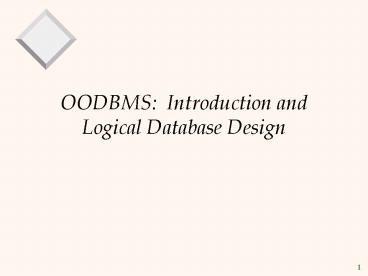OODBMS: Introduction and Logical Database Design - PowerPoint PPT Presentation
Title:
OODBMS: Introduction and Logical Database Design
Description:
Why OO? Relational Systems are limited: Structural restrictions on data Missing semantics (value-based relationships) Linguistic limitations (SQL and Algebra) PL ... – PowerPoint PPT presentation
Number of Views:65
Avg rating:3.0/5.0
Title: OODBMS: Introduction and Logical Database Design
1
OODBMS Introduction and Logical Database Design
2
Why OO?
- Relational Systems are limited
- Structural restrictions on data
- Missing semantics (value-based relationships)
- Linguistic limitations (SQL and Algebra)
- PL communitys OO work is appealing
- More realistic data structures
- Explicit relationships and behavior modeling
- Tighter interface between DBMS and PL
- New applications
- CAD, OIS, hypertext, geograph. data, multimedia,
medical data, music, hierarchical data, ...
3
Fundamental OO Concepts
- Complex object structure
- Explicit relationships
- Object identity globally unique OIDs
- Methods (behavior) an inherent part of model
- used to model integrity constraints!
- written in a real programming language
- Subclasses and inheritance
- structure (attributes) and behavior (methods)
- Private vs. public attributes and methods
4
OODBMS Required Features
- Complex Objects (set, tuple, list)
- OID (value-independent, permanent)
- Encapsulation (overriding it?)
- Classes/Types (maintain extents?)
- Subclasses (multiple superclasses?)
- Late binding for overridden methods
- Turing-complete host language
- Seamless type extensibility
5
OODBMS Required Features (cont)
- Persistence enforced by system
- Handle large DBs (indexing, buffering, etc.)
- Concurrency support
- Recovery support
- Must provide a simple (declarative, optimizable)
query language - Separate constraint mechanisms?
- Views?
6
Solution 1 Object-Oriented DBMS
- Idea Take an OO language like C, add
persistence collections. - class frame
- int frameno
- jpeg image
- int category
- persistent set ltframe gt frames
- foreach (frame f, frames)
- return f-gtimage-gtthumbnail()
- Shut down the program. Start it up again.
Persistent vars (e.g. frames) retain values!
7
OODBMS applications
- OODBMSs good for
- complex data
- easier integration with application code
- integrated modeling of behavior and structure
- Problems
- lack of backward compatibility
- some argue its back to the network data model
- standards still emerging
- A modest success in the marketplace
8
Solution 2 Object-Relational
- Idea Add OO features to the type system of SQL.
I.e. plain old SQL, but... - columns can be of new types (ADTs)
- user-defined methods on ADTs
- columns can be of complex types
- reference types and deref
- inheritance
- old SQL schemas still work! (backwards
compatibility) - Many relational vendors moving this way (SQL3).
Big business!
9
New features in SQL-3 DML
- Built-in ops for complex types
- e.g. the typical set methods, array indexing,
etc. - dot notation for tuple types
- Operators for reference types
- deref(foo)
- shorthand for deref(foo).bar foo-gtbar.
- User-defined methods for ADTs.
- Support for recursive queries
10
Stonebrakers Application Matrix
No Query
Query
Complex Data
OODBMS
ORDBMS
File System
Simple Data
RDBMS
Thesis Most applications will move to the
upper right.
11
Perspectives
- RDBMS OO ORDBMS
- Object-Relational DBMS
- Looks and feels like a better RDBMS
- Emerging standard SQL-3
- OOPL DB OODBMS
- Looks and feels more like a programming
language than does an ORDBMS - In reality, built from ground up
- Uses RDBMS techniques in an OO setting
- Emerging standard OQL
12
Summary
- OO/ORDBMS offers many new features.
- But not clear how to use them!
- Schema design techniques not well understood
- Query processing techniques still in research
phase. - A moving target for OO/OR DBAs!
- Prediction You will use an OO/ORDBMS in the
future.
13
Current Products
- Some OR features supported in
- Oracle 8
- IBM DB2
- Informix UDS
- UniSQL
- Some OODBMS products
- O2
- ObjectStore
- Objectivity
- Versant, Jasmine, Titanium, Poet,
14
State of the Art (general OO/OR)
- Incorporating new data types
- Modeling ordered data
- Querying ordered data
- Indexing techniques
- Mapping objects to relations
- OO/OR benchmarks
- Garbage collection techniques
NEXT WEEK Object Modeling Object Querying































